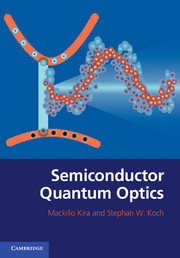Book contents
- Frontmatter
- Contents
- Preface
- 1 Central concepts in classical mechanics
- 2 Central concepts in classical electromagnetism
- 3 Central concepts in quantum mechanics
- 4 Central concepts in stationary quantum theory
- 5 Central concepts in measurement theory
- 6 Wigner's phase-space representation
- 7 Hamiltonian formulation of classical electrodynamics
- 8 System Hamiltonian of classical electrodynamics
- 9 System Hamiltonian in the generalized Coulomb gauge
- 10 Quantization of light and matter
- 11 Quasiparticles in semiconductors
- 12 Band structure of solids
- 13 Interactions in semiconductors
- 14 Generic quantum dynamics
- 15 Cluster-expansion representation of the quantum dynamics
- 16 Simple many-body systems
- 17 Hierarchy problem for dipole systems
- 18 Two-level approximation for optical transitions
- 19 Self-consistent extension of the two-level approach
- 20 Dissipative extension of the two-level approach
- 21 Quantum-optical extension of the two-level approach
- 22 Quantum dynamics of two-level system
- 23 Spectroscopy and quantum-optical correlations
- 24 General aspects of semiconductor optics
- 25 Introductory semiconductor optics
- 26 Maxwell-semiconductor Bloch equations
- 27 Coherent vs. incoherent excitons
- 28 Semiconductor luminescence equations
- 29 Many-body aspects of excitonic luminescence
- 30 Advanced semiconductor quantum optics
- Appendix Conservation laws for the transfer matrix
- Index
- References
10 - Quantization of light and matter
Published online by Cambridge University Press: 05 January 2012
- Frontmatter
- Contents
- Preface
- 1 Central concepts in classical mechanics
- 2 Central concepts in classical electromagnetism
- 3 Central concepts in quantum mechanics
- 4 Central concepts in stationary quantum theory
- 5 Central concepts in measurement theory
- 6 Wigner's phase-space representation
- 7 Hamiltonian formulation of classical electrodynamics
- 8 System Hamiltonian of classical electrodynamics
- 9 System Hamiltonian in the generalized Coulomb gauge
- 10 Quantization of light and matter
- 11 Quasiparticles in semiconductors
- 12 Band structure of solids
- 13 Interactions in semiconductors
- 14 Generic quantum dynamics
- 15 Cluster-expansion representation of the quantum dynamics
- 16 Simple many-body systems
- 17 Hierarchy problem for dipole systems
- 18 Two-level approximation for optical transitions
- 19 Self-consistent extension of the two-level approach
- 20 Dissipative extension of the two-level approach
- 21 Quantum-optical extension of the two-level approach
- 22 Quantum dynamics of two-level system
- 23 Spectroscopy and quantum-optical correlations
- 24 General aspects of semiconductor optics
- 25 Introductory semiconductor optics
- 26 Maxwell-semiconductor Bloch equations
- 27 Coherent vs. incoherent excitons
- 28 Semiconductor luminescence equations
- 29 Many-body aspects of excitonic luminescence
- 30 Advanced semiconductor quantum optics
- Appendix Conservation laws for the transfer matrix
- Index
- References
Summary
Chapters 7–9 present the classical description of many-body systems in a way that allows us to identify the canonical variables for the coupled system of matter and electromagnetic fields. Thus, we are now in the position to apply the canonical quantization scheme outlined in Section 3.2.3. We already know that the quantization extends the particle concept to include also wave aspects such that the overall description satisfies the wave–particle duality. Once both matter and light are quantized, we have a full theory which can be applied to treat many interesting phenomena in the field of semiconductor quantum optics.
The quantization is conceptually more challenging for light than for particles because Maxwell's equations already describe classical waves. However, the mode expansion for the vector potential and the generalized transversal electric field allows us to identify the particle aspects associated with light waves. This approach presents the system dynamics in the form of classical Hamilton equations for the mode-expansion coefficients. Thus, the canonical quantization deals with these coefficients and supplements an additional wave character to them. In other words, the light quantization introduces complementarity at several levels: classical light is already fundamentally a wave while its dualistic particle aspects emerge in ray-like propagation, as discussed in Chapter 2. At the same time, the mode expansion identifies additional particle aspects and the quantization of the mode-expansion coefficients creates a new level of wave–particle dualism. In this chapter, we apply the canonical quantization scheme to derive the quantized system Hamiltonian.
- Type
- Chapter
- Information
- Semiconductor Quantum Optics , pp. 193 - 217Publisher: Cambridge University PressPrint publication year: 2011

